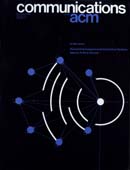November 1974 - Vol. 17 No. 11

Features
Improving locality by critical working sets
A new approach to program locality improvement via restructuring is described. The method is particularly suited to those systems where primary memory is managed according to a working set strategy. It is based on the concept of critical working set, a working set which does not contain the next memory reference. The data the method operates upon are extracted from a trace of the program to be restructured. It is shown that, except in some special cases, the method is not optimum. However, the experimental results obtained by using the method to restructure an interactive text editor and the file system module of an operating system have shown its substantial superiority over the other methods proposed in the literature.
A locally-organized parser for spoken input
This paper describes LPARS, a locally-organized parsing system, designed for use in a continuous speech recognizer. LPARS processes a string of phonemes which contains ambiguity and error. The system is locally-organized in the sense that it builds local parse structures from reliable word candidates recognized anywhere in an input utterance. These local structures are used as “islands of reliability” to guide the search for more highly garbledwords which might complete the utterance.
A method for composing simple traditional music by computer
A method is described for composing musical rounds by computer. This method uses some music theory plus additional heuristics. Fundamental to the method is a set of productions together with sets of applicability rules and weight rules which operate on the productions deciding when and to what extent they are available for use.
Several rounds generated by the computer implementation of the method are presented. Generally, the resultant music sounds mediocre to the professional although usually pleasing to the layman. It appears that full-blown music theory is not needed for rounds—all the hardware required for structural levels is not necessary for these pieces. The author has tried to address both musicians and computer scientists.
Register allocation via usage counts
This paper introduces the notion of usage counts, shows how usage counts can be developed by algorithms that eliminate redundant computations, and describes how usage counts can provide the basis for register allocation. The paper compares register allocation based on usage counts to other commonly used register allocation techniques, and presents evidence which shows that the usage count technique is significantly better than these other techniques.
Self-stabilizing systems in spite of distributed control
The synchronization task between loosely coupled cyclic sequential processes (as can be distinguished in, for instance, operating systems) can be viewed as keeping the relation “the system is in a legitimate state” invariant. As a result, each individual process step that could possibly cause violation of that relation has to be preceded by a test deciding whether the process in question is allowed to proceed or has to be delayed. The resulting design is readily—and quite systematically—implemented if the different processes can be granted mutually exclusive access to a common store in which “the current system state” is recorded.



